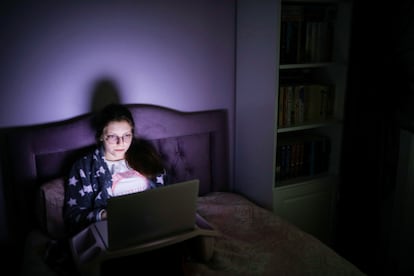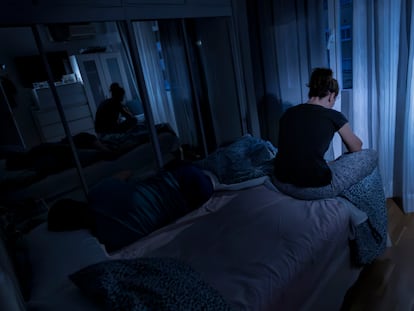Why night owls are at higher risk of dying earlier: It’s the alcohol and tobacco, not their sleep habits
A new study rules out a direct relationship between being an evening person and a higher mortality, but finds that those who go to bed and wake up later are more likely to be smokers and drinkers

“Humans are daytime animals,” explains María Ángeles Bonmatí, postdoctoral researcher at the Carlos III Health Institute’s Networked Biomedical Research Center and author of Que nada te quite el sueño [Don’t let anything keep you awake]. In other words, we are physiologically wired to be active during the day and to rest at night. However, within this general pattern, adds Bonmatí, “people can be classified into different chronotypes” based on their internal clocks, conditioned by their circadian rhythms. To simplify, we can talk about people with an evening chronotype and people with a morning chronotype.
“A morning person tends to wake up and go to bed earlier, and they usually prefer to do physical exercise first thing in the morning. In addition, they are usually hungrier when they get up and therefore need to have breakfast early. On the other hand, evening people, who tend to go to bed and wake up later, may prefer to delay breakfast for a bit or hold out with just a cup of coffee (those who drink it) and tend to prefer physical exercise in the afternoon,” says María José Martínez Madrid, coordinator of the chronobiology working group of the Spanish Sleep Society, researcher at the University of Murcia and founding partner of the firm Kronohealth. She adds that these preferences also affect the cognitive level: people with a morning chronotype tend to get up early to study or perform any other activity that requires concentration or precision, while those with an evening chronotype prefer to do these activities at night.
Although — as Martínez Madrid acknowledges — there is not much scientific evidence on the direct relationship between chronotype and mortality, various studies, she points out, have noticed a greater morbidity (the proportion of people who get sick) associated with the evening chronotype, which, “hypothetically and ultimately,” could lead to an increase in mortality: “A direct relationship has been found between the evening chronotype and eating disorders (such as overweight, obesity and unhealthy metabolic biomarkers) or circadian disorders such as social jetlag” — a considerable discrepancy in the times of waking up and going to bed during days off. “Furthermore, at a psychological level, the evening chronotype has been shown to be a risk factor for depressive disorders and substance use disorders, while the morning chronotype appears to act as a protective factor,” she adds.
This view is shared by Bonmatí, who points out that, although the evening chronotype had already been associated with a greater probability of presenting cardiovascular risk factors (such as obesity or tobacco use), studies on this matter “showed an increase in mortality with the evening chronotype, regardless of these associated factors.” An increase in mortality that, up to now, the researcher points out, had been linked to an increase in behavioral, psychological and physiological risk factors, some of which could be attributed to a chronic mismatch between the internal physiological clocks of these people and the socially imposed activity and work schedules. “In short, the ultimate cause might not be so much the evening chronotype per se as much as the time difference or social jetlag to which people with this chronotype are subjected to for most of their lives,” she adds.
Bad habits at night
A recent study published in the journal Chronobiology International with data obtained after a 37-year follow-up of more than 23,000 Finnish adults, has concluded that the higher mortality associated with the evening chronotype (estimated at 9% in the study) could be fundamentally due to two bad habits: smoking and drinking. In fact, according to the study, in the case of non-smokers who at most are occasional drinkers, no association of the evening chronotype with mortality was found. “I think the most important message from our study is that night owls are not at increased risk of death. The chronotype is a personal characteristic, but for unknown reasons we see that unhealthy lifestyles seem to occur more frequently among night people,” explains Jaakko Kaprio, a professor at the Department of Public Health of the University of Helsinki and co-author of the study.
Among those reasons he alludes to several hypotheses, including that night owls may have a tendency to stay up later at parties and bars and are therefore more likely to smoke and drink more; it could also be that, in an inverse relationship, these bad habits have the potential to change a person’s chronotype, or that there are genes that affect both the chronotype and the consumption of alcohol and tobacco.
Along the same lines, María Ángeles Bonmatí — who points out that several studies had already shown that evening people, on average, show a greater probability of consuming more alcohol and being smokers than morning people — mentions that in 2010 an article was published in which the authors suggested that an evening chronotype would not necessarily lead directly to a greater mental imbalance, but that only those evening people who also smoke and drink would obtain lower scores in psychological well-being. “According to these authors, the frequent jetlag in evening people (who are forced to comply with morning schedules during the week) would generate a stress that some people compensate by smoking. Smoking, therefore, could be a way of coping with social jetlag, similar to the higher consumption of other stimulants such as alcohol or caffeinated drinks,” she reflects.
For Bonmatí, the Finnish study “breaks with previous evidence” that showed an increase in mortality due to the evening chronotype by itself, but points out that the study was carried out with Finnish population, “with geographical and cultural characteristics — closely related to aspects that influence our physiology — which differ from those of other places.” So, in her opinion, “it would be bold to categorically state” that there are no other associated risks to the evening chronotype besides these bad habits. “We will have to continue researching and studying other related aspects until the evidence is clear in one direction or another.”
The social stigma of nightlife
For Kaprio, regarding public health policies, it is important to know whether an exposure or behavior (in this case the evening chronotype) that is associated with poor health, disease or death is a real cause or just an indicator or a warning sign somehow correlated with the real cause. “For instance, having yellow fingers is associated with an increased risk of lung cancer, but it is not a cause of cancer. Yellow fingers are an indicator of heavy and prolonged smoking, the actual cause of lung cancer. Launching a campaign for everyone to clean their fingers properly and regularly would not reduce lung cancer. Only quitting smoking (and preventing the initiation of smoking) would really reduce the risk of lung cancer,” he exemplifies, before highlighting that, in this sense, the study findings actually provide reassurance to people who might worry about being night owls: “It is difficult to influence a person’s chronotype, but, on the other hand, most people can reduce their alcohol consumption and quit smoking. And if they can’t do it alone or with the support of family and friends, they should seek professional help.”
Ángeles Bonmatí states that, although we must be prudent and wait for confirmation of these results in other populations “and with more precise chronotype evaluations” than those used in the research, the results of the study may help us look at the supposed negative effects of the evening chronotype from another perspective and realize that bad habits, avoidable in many cases, have a lot to do with these health effects. “For now, it doesn’t hurt to try to make the population aware of the importance of avoiding tobacco and alcohol consumption,” she argues.
María José Martínez Madrid points out that sometimes evening people feel misunderstood and judged, a situation of vulnerability that can incite the consumption of substances such as tobacco and alcohol. “If there is not a direct and exclusive association between the chronotype and the increase in morbidity or mortality, it would be interesting to study more about why these evening people acquire worse habits. In fact, we could consider matters such as whether society is made exclusively for morning people or if being an evening person is frowned upon, as if it were a choice,” reflects the spokesperson for the Spanish Sleep Society. For her, in an ideal situation, the time preference of each person should be taken into account to the extent possible, to establish different work shifts “so that there would be more job security, greater personal satisfaction and, therefore, higher productivity.”
Sign up for our weekly newsletter to get more English-language news coverage from EL PAÍS USA Edition
Tu suscripción se está usando en otro dispositivo
¿Quieres añadir otro usuario a tu suscripción?
Si continúas leyendo en este dispositivo, no se podrá leer en el otro.
FlechaTu suscripción se está usando en otro dispositivo y solo puedes acceder a EL PAÍS desde un dispositivo a la vez.
Si quieres compartir tu cuenta, cambia tu suscripción a la modalidad Premium, así podrás añadir otro usuario. Cada uno accederá con su propia cuenta de email, lo que os permitirá personalizar vuestra experiencia en EL PAÍS.
¿Tienes una suscripción de empresa? Accede aquí para contratar más cuentas.
En el caso de no saber quién está usando tu cuenta, te recomendamos cambiar tu contraseña aquí.
Si decides continuar compartiendo tu cuenta, este mensaje se mostrará en tu dispositivo y en el de la otra persona que está usando tu cuenta de forma indefinida, afectando a tu experiencia de lectura. Puedes consultar aquí los términos y condiciones de la suscripción digital.
More information
Archived In
Últimas noticias
There is as much life left to discover on planet Earth as that which is already known
Dozens presumed dead, around 100 injured in fire at Swiss Alps bar during New Year’s celebration
Is porn for women different from conventional porn? We spoke to those who make it
Cartagena de Indias is sinking: What can the city do to mitigate it?
Most viewed
- Sinaloa Cartel war is taking its toll on Los Chapitos
- Reinhard Genzel, Nobel laureate in physics: ‘One-minute videos will never give you the truth’
- David King, chemist: ‘There are scientists studying how to cool the planet; nobody should stop these experiments from happening’
- Oona Chaplin: ‘I told James Cameron that I was living in a treehouse and starting a permaculture project with a friend’
- The Interoceanic Train, the Mexican alternative to the Panama Canal











































